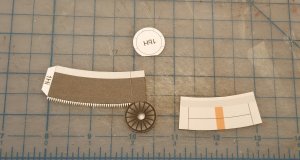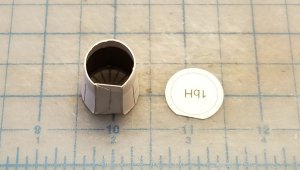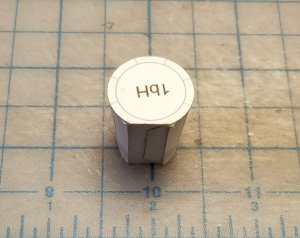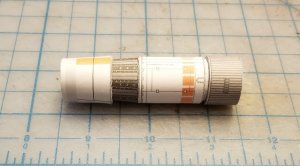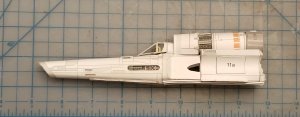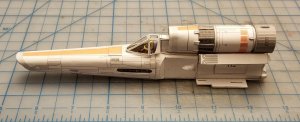SCORPION SHIPYARDS beta test build of the Colonial Viper MK-I
- Thread starter Rhaven Blaack
- Start date
You are using an out of date browser. It may not display this or other websites correctly.
You should upgrade or use an alternative browser.
You should upgrade or use an alternative browser.
It is time for another installment of photos. I am now working on the engines. I have started with the high engine first. SInce there are quite a few photos, I will be making a few posts just for the high engine.
Here are the parts sheets for all three engines, as well as the alternative intake skins.
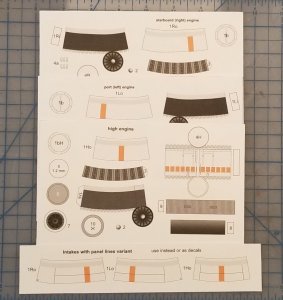
I started with the exhaust.
Here are the parts for the base of the exhaust.
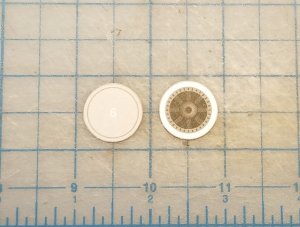
The base is assembled.
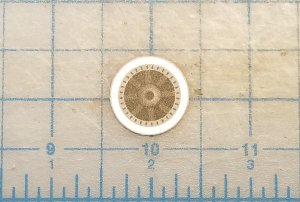
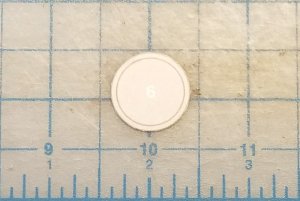
The exhaust is assembled.
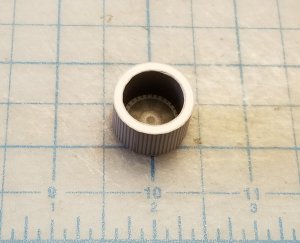
With this assembly of this engine, make certain that you line up the seams of all the parts, so that it will "draw" a solid line through the engine.
Here are the parts sheets for all three engines, as well as the alternative intake skins.

I started with the exhaust.
Here are the parts for the base of the exhaust.

The base is assembled.


The exhaust is assembled.

With this assembly of this engine, make certain that you line up the seams of all the parts, so that it will "draw" a solid line through the engine.
Last edited:
On to the main body of the engine.
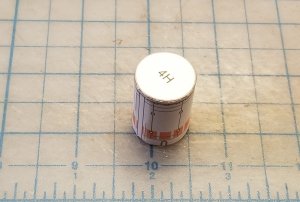
Here is the collar that goes between the main body of the engine and the intake.
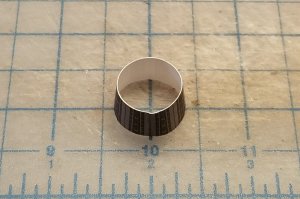
The collar is attached.
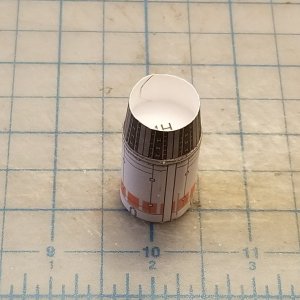
Here is the exhaust, the spacer between the exhaust and the main body of the engine and the main body of the engine.
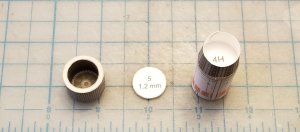
The spacer is attached.
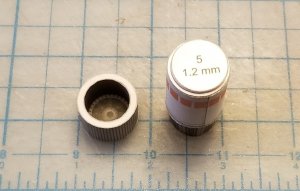
The exhaust is attached.
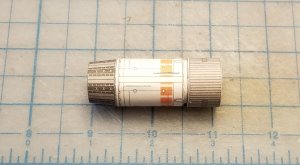

Here is the collar that goes between the main body of the engine and the intake.

The collar is attached.

Here is the exhaust, the spacer between the exhaust and the main body of the engine and the main body of the engine.

The spacer is attached.

The exhaust is attached.

Now for the greebling. Here are the parts for it.
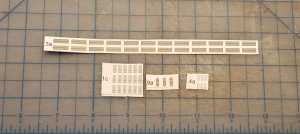
When you apply part 9a, make certain that it lays on the lengthways centerline of the engine, in the exhaust.
I did add a little extra details by raising squares that are on top of the part.
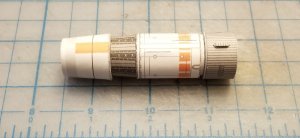
Here is a side view of it.
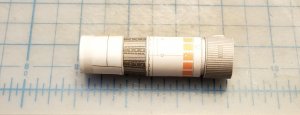
I did the same thing with part 4a
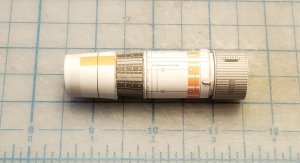
I apply parts 1c (intake clamps) and 3a (collar pipes)
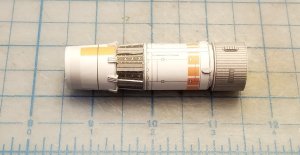
I shaped the intake.
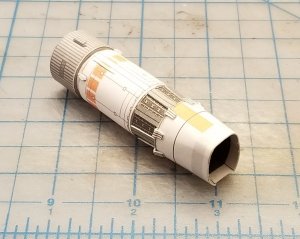

When you apply part 9a, make certain that it lays on the lengthways centerline of the engine, in the exhaust.
I did add a little extra details by raising squares that are on top of the part.

Here is a side view of it.

I did the same thing with part 4a

I apply parts 1c (intake clamps) and 3a (collar pipes)

I shaped the intake.

That looks great! 
When I took a look at the fan texture I noticed that you can in fact implement @zathros 's idea to add a spinning fan inside, even on the high engine. The space is sufficient and the graphics show the complete lamellae. You may have to cut them a tad shorter to compensate for the layer thickness (the thicker the fan the smaller the usable diameter of the intake) but in theory it should work.
When I took a look at the fan texture I noticed that you can in fact implement @zathros 's idea to add a spinning fan inside, even on the high engine. The space is sufficient and the graphics show the complete lamellae. You may have to cut them a tad shorter to compensate for the layer thickness (the thicker the fan the smaller the usable diameter of the intake) but in theory it should work.
Thank you! While building this, I am mapping out the areas where and what I can greeble. Layering the fans is something that I am planning on doing. As for being able to make them actually spin is something that I have not considered. However, it is certainly not out the realm of possibilities. With that being said though, I do think that layering the fan blades, would give a bit of added strength to the connections of the component as a whole. Like I mentioned before, this is something that i will be working on the next time I build this model.That looks great!
When I took a look at the fan texture I noticed that you can in fact implement @zathros 's idea to add a spinning fan inside, even on the high engine. The space is sufficient and the graphics show the complete lamellae. You may have to cut them a tad shorter to compensate for the layer thickness (the thicker the fan the smaller the usable diameter of the intake) but in theory it should work.
- Apr 5, 2013
- 13,876
- 10,215
- 228
Making them would be a "PIA", but the vanes really do "Pop" inside of those intakes. 
Rhaven is the Master of PIA designs, so I guess we may look forward to his own take on this model. I can already hear the little gears spinning in his head..!Making them would be a "PIA", but the vanes really do "Pop" inside of those intakes.
Making them would be a "PIA", but the vanes really do "Pop" inside of those intakes.
Gentlemen, thank you very much for the compliment!Rhaven is the Master of PIA designs, so I guess we may look forward to his own take on this model. I can already hear the little gears spinning in his head..!
I have to say that I pride myself on such. It, in many ways, has became a strong trait of mine, over the years. Many time, when I have told people about this wonderful hobby and what all you can do with it, have asked me when am I going to stop playing around and get into "REAL MODEL" building? I would respond with "What do you mean by "REAL MODEL" building? They would all same the very same thing; "when are you going to start building "real models"? I would then ask, what is a "real model"? They would respond; "PLASTIC" models. Because, you can get very detailed with plastic models, where you cannot with paper. So, I responded; The definition of a model is a representation of something REGARDLESS of the material or medium. So, paper model building is "REAL MODEL" building. WIth that being said, I have endeavoured to make models as "realistic" looking and to put in as much detail as possible, regardless of the genre. :hide:
A model is a small rendition of reality, no matter which material was used. Period. 
Your right RBGentlemen, thank you very much for the compliment!rinks: YES, yes, I am indeed the MASTER of PIA design! :hide:
I have to say that I pride myself on such. It, in many ways, has became a strong trait of mine, over the years. Many time, when I have told people about this wonderful hobby and what all you can do with it, have asked me when am I going to stop playing around and get into "REAL MODEL" building? I would respond with "What do you mean by "REAL MODEL" building? They would all same the very same thing; "when are you going to start building "real models"? I would then ask, what is a "real model"? They would respond; "PLASTIC" models. Because, you can get very detailed with plastic models, where you cannot with paper. So, I responded; The definition of a model is a representation of something REGARDLESS of the material or medium. So, paper model building is "REAL MODEL" building. WIth that being said, I have endeavoured to make models as "realistic" looking and to put in as much detail as possible, regardless of the genre. :hide:
I think that paper modeling is more difficult than plastic. You make something in 3D with a 2D thing. Isn't great. Ok....with plastic you can make some realistic diorama but, you ca do almost the same thing with paper. You just have to be more creative. IT IS REAL MODEL !
By the way......your model come along great . Just impatient to get to it.
@Danscrew Thank you very much for the kind words and encouragement! I greatly appreciate it!
There is a problem with the "PLASTIC" argument. "They" didn't get detailed with the plastic, the model company got detailed with the plastic. Mostly, "They" just assemble and paint, not much better then a "Paint-by-Number" in my opinion. Wear as, with paper you have to make each and every part, and if you don't like a color or how a part fits, fix it or recolor it on the computer and print another. You can also change the scale with paper models. I would like to see them do THAT with a purchased plastic kit.Gentlemen, thank you very much for the compliment!rinks: YES, yes, I am indeed the MASTER of PIA design! :hide:
I have to say that I pride myself on such. It, in many ways, has became a strong trait of mine, over the years. Many time, when I have told people about this wonderful hobby and what all you can do with it, have asked me when am I going to stop playing around and get into "REAL MODEL" building? I would respond with "What do you mean by "REAL MODEL" building? They would all same the very same thing; "when are you going to start building "real models"? I would then ask, what is a "real model"? They would respond; "PLASTIC" models. Because, you can get very detailed with plastic models, where you cannot with paper. So, I responded; The definition of a model is a representation of something REGARDLESS of the material or medium. So, paper model building is "REAL MODEL" building. WIth that being said, I have endeavoured to make models as "realistic" looking and to put in as much detail as possible, regardless of the genre. :hide:


Here are parts for the side engines. Since the main body and the exhaust (for the most part) are the same, I just skipped ahead to the air-intakes.
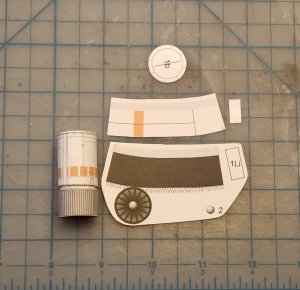
Here is the outer skin for the intake. The piece of paper to the side is a very thin piece of paper that I use to seal the seam.

The inner and outer skins of he intake are assembled.
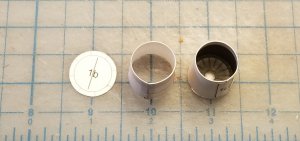
I slid the inner skin inside the outer skin and attached the back-cap.
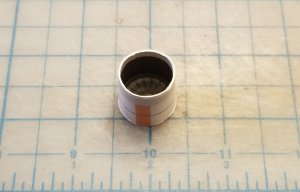
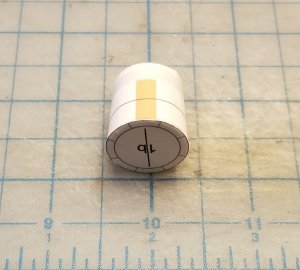
I dry fitted the wing and placed engine in the engine mount, to align the placement of the intake.
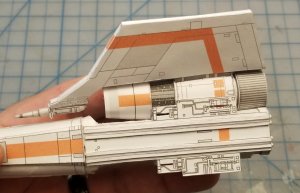
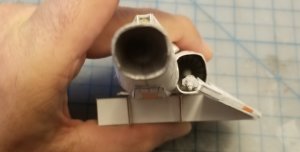
The main assembly of the engine is finished.

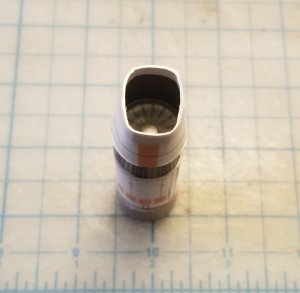
I added all of the greebles.
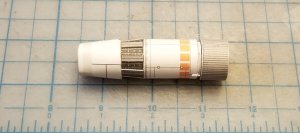
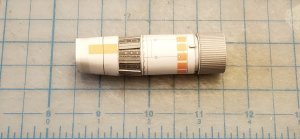
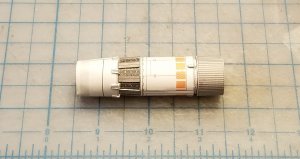
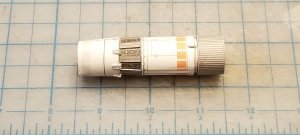

Here is the outer skin for the intake. The piece of paper to the side is a very thin piece of paper that I use to seal the seam.

The inner and outer skins of he intake are assembled.

I slid the inner skin inside the outer skin and attached the back-cap.


I dry fitted the wing and placed engine in the engine mount, to align the placement of the intake.


The main assembly of the engine is finished.


I added all of the greebles.




So, now it is time to mount the engines and wings.
I attached the tail to the high engine.
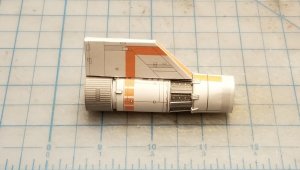
I attached the wings to the engines.
(*NOTE* You should mount the engines to the engine mount first, then mount the wings to the engines. *NOTE*)
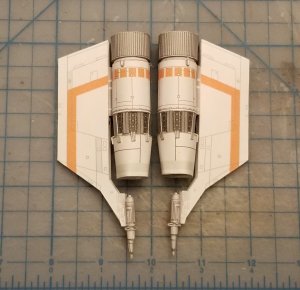
This part covers the open space between the side engine and the engine mount.
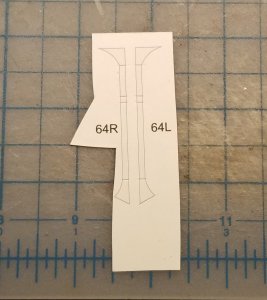
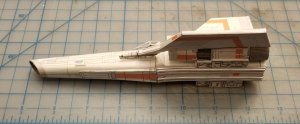
There is still quite a bit of work that I need to do on this. However, I wanted to see (and show) what it looks like on the launch rail.
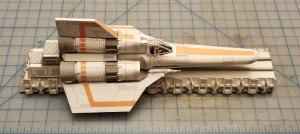
Here is a comparison shot of both the @Revell-Fan version and the @sirius version.
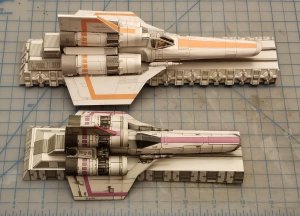
Please stay tuned to your local Colonial Broadcast Network for further updates as they come in.
I attached the tail to the high engine.

I attached the wings to the engines.
(*NOTE* You should mount the engines to the engine mount first, then mount the wings to the engines. *NOTE*)

This part covers the open space between the side engine and the engine mount.


There is still quite a bit of work that I need to do on this. However, I wanted to see (and show) what it looks like on the launch rail.

Here is a comparison shot of both the @Revell-Fan version and the @sirius version.

Please stay tuned to your local Colonial Broadcast Network for further updates as they come in.
Not only that, but with plastic, if you make a mistake or break a part, you have to buy a brand new kit (that is if the kit is still available). However, with paper/cardstock, if you make a mistake or break something, you can (for the most part) print out new parts and start over again (which I have done countless times). Not only that, but if you want to make multiples; with plastic, you have to go out and buy more kits (if they are available), with paper/cardstock, you just print out another set(s) of templates. The best overall comparison between plastic and paper/cardstock model is cost. Most plastic models are now $20.00 - $50.00 (depending on what you are looking for). On the other hand, (with the exception of the commercial models, which are still relatively cheaper than plastic) paper/cardstock model templates are free. The majority of the cost is the paper/cardstock (cheap), ink (cheap), paint (depending on the type and brand, for the most part is cheap), and glue (cheap).There is a problem with the "PLASTIC" argument. "They" didn't get detailed with the plastic, the model company got detailed with the plastic. Mostly, "They" just assemble and paint, not much better then a "Paint-by-Number" in my opinion. Wear as, with paper you have to make each and every part, and if you don't like a color or how a part fits, fix it or recolor it on the computer and print another. You can also change the scale with paper models. I would like to see them do THAT with a purchased plastic kit.
Absolutely fantastic!!! thumbsupthumbsupthumbsup


